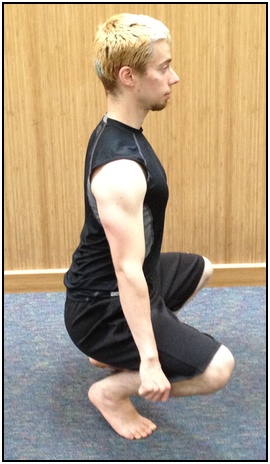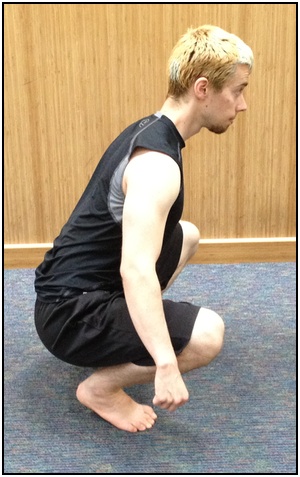Why I Use Hindu Squats
For Lower Body Power
Hindu squats are a very fun exercise! In additional to building great leg strength, they force you to work on your balance and build lower-to-upper body power transfer skill (useful in martial arts and athletics).
Weight training is one of the best methods of strength training! If you want to start weight training safely and effectively, with the best info, diet, and routines, check out the 5 Day Beginner Weight Training Course!
These squats are also fun because you need no extra equipment to do them! Wherever you are, whenever you want to train, you can use these squats.
Why 'Hindu' Squats?
Body weight squats were used by the Great Gama Pehalwaan, one of the most famous wrestlers to ever come out of India, in his training routine. Called baithak, Gama supposedly did 4,000 of them every morning to develop his impressive leg strength and endurance. One of Gama's original squat variations also had you holding your hands on your hips rather than letting them swing freely.[1]
Bruce Lee read articles about Gama, and thereafter added body weight squats (and several other exercises) to his own training routine.[2] This helped to popularize them even more.
But why 'hindu'? They came from India, and somewhere along the way the name 'hindu squats' stuck.
Basic Hindu Style Squats
A basic hindu squat is very simple. It's simply a body weight squat down onto your toes, while keeping your back straight. Then you power back up!
Here're some photos to show you correct form…
1. Top
Stand upright, with your back straight, hands hanging at your sides. Pretty simple.

2. Bottom
Squat straight down, keeping your back straight. At the same time come up on the balls of your feet and balance, letting your arms hang loosely at your sides.

3. Back to Top
Stand up explosively, swinging your arms up and outward in a relaxed fashion. Remember, don't hold any tension in your arms.
After you come up you can come back down again as your arms fall. This will make your arm action resemble rowing.
Notes On Proper Form…
◆ Inhale on the way down, and exhale on the way up. I find this method, coordinating the upward power movement with an exhale, very helpful.
◆ Make sure you hold your back straight and vertical. It can help to imagine your spine like a cord pulled tight between your butt and your head. However you do it, keep your spine vertical and stay balanced.
Why Your Arms Are Important
In hindu squats, your arms hang loosely at your side and rotate out in front of you. This relaxed swing is vital to maintain.
See, these squats do a lot more than just develop leg strength. They train your body to source power from your hips and lower body - which most people are really crappy at.
If you keep doing hindu style squats, you'll build the ability to more efficiently use lower body power in your upper body. Which is a really useful skill for wrestling, martial arts, or really any kind of athletic endeavor.
Why Do Hindu Squats?
- Builds Great Cardio
- Build Awesome Explosive Leg Strength
- Gives You A Better Sense of Balance
- Improves Lower Body to Upper Body Power Transfer
Drawbacks...
1. Hard on the Knees
Squats can be really hard on your knees, especially in you have knee pain or an old injury. If you have knee issues, you might want to skip these.
2. Difficult to Balance
With hindu style squat exercises it can be difficult to stay upright when you're starting. Make sure you're paying attention to balance, and go slow in the beginning. You don't want to hurt yourself while doing something stupid, do you?
Making Them Harder!
◆ Jumping!
Making hindu squats into jump squats is a natural progression. Instead of coming just up to standing, jump into the air as you swing your arms out.
Just make sure to catch yourself softly on the way back down. Otherwise you can really f*ck up your knees and/or ankles.
◆ Weight Vest
A weight vest is the best way to add resistance after jumping hindu squats become too difficult for you. It also keeps the additional weight attached to the trunk of your body, leaving your arms free and making possible to maintain balance even while adding weight.
◆ Belt With Weights
Like a weight vest, a belt with weights adds resistance to the movement that you're already doing. It also keeps the weight around your hips, so that it won't interfere with the balance component of this exercise.
Of course, if you're interested in working with weights get a good beginning program to start out with. But transitioning from body weight exercises like hindu squats to weighted movements is an excellent way to get stronger.
Common Errors…
◆ Tight Arms
You must allow the arms to swing to get the full benefits of this squat exercise. If you don't let the arms swing, you won't be doing hindu squats.
◆ Crooked Torso
Keeping your torso upright is very important for balance, and for not hurting your back. Make sure you keep your spine straight and upright.
Do NOT do this...

◆ Rolling Your Ankles
If your ankles are out of alignment, when you come down from doing these squats you can hurt your ankles. Keep your ankles straight, and don't push yourself to the point where your form falls apart.
Oh, and be sure to sign up for the e-zine Starting Strong to get monthly strength training, exercise, and diet tips e-mailed to you - and access to the free e-book Train Smart, Eat Smart: Exercise Nutrition Hacks!
• Click HERE to learn more about Body Weight Exercises!
OR
• Click here to leave 'Why I Use Hindu Squats For Lower Body Power' & go back to the Home-page!
References:
1. Lee, Bruce, and John R. Little. 1998. The Art of Expressing the Human Body. Boston: C.E. Tuttle Co. Pp. 58.
2. Ibid.
Search CST...
|
Tweet Follow @Aaron_CST |
|
"About 2 weeks ago I read all the ab strengthening stuff on your site because I decided I wanted to be strong, instead of having a lot of belly fat. So I started eating healthier, running, exercising, you name it - everything your site said to do to help. Now I am noticing a real difference! Thank you for making this. :D xD" ~ Julia |
|
[This calorie calculator is] the most useful tool on the web that I can find… Also, I compared the calories calculated by your calculator to the calories calculated by the treadmill at my gym, and they're within a couple calories of each other, so yours is as accurate as we're going to get. REALLY AWESOME TOOL. I love it and depend on it. Thank you sooooo much for making this available." ~ Galit Sharon Marcus |
|
Thank you very much, I was too lean before 2 years (55 Kgs), after the gym now I'm 72kgs, all the muscles have developed... when someone hand shakes with me it can be squeezed easily, they're making fun of me! ~ Tamil Arasan |






New! Comments
Have your say about what you just read! Leave me a comment in the box below.